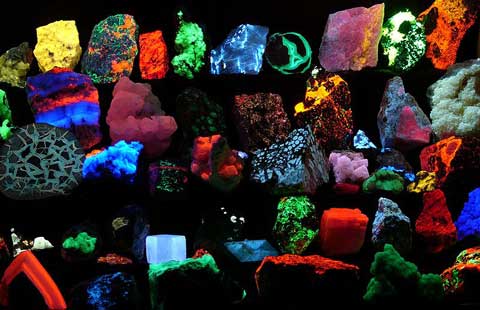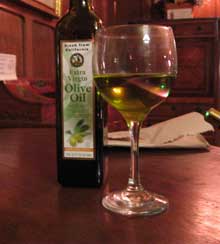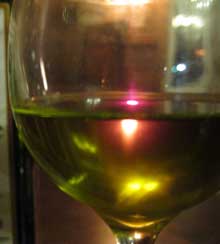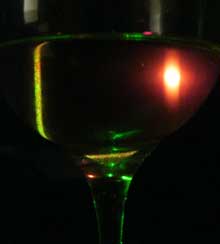Fluorescent Olive Oil
Fluorescence occurs when a substance absorbs light of a certain wavelength and emits light of a different wavelength. You’ve most likely seen this effect before with most glow-in-the-dark objects, but you don’t need glow sticks to see fluorescence in action at home!

Image Credit: Hannes Grobe via Wikimedia Commons.

Figure 1

Figure 2

Figure 3
What You Need
- Olive oil
- Clear glass to hold the olive oil
- Green laser pointer
- Optional: second laser pointer of a different color
What to Do
This Physics@Home is as simple as 1, 2, 3.
- Fill the glass with an inch or two of Olive Oil.
- Shine the green laser into the Olive Oil. (Figure 1)
- Shine the second laser pointer (my laser is violet) at the Olive Oil. (Figure 2)
- Sit back and observe the differences
What's Going On?
Molecules in the olive oil absorb some of the higher energy light photons from the laser before releasing lower energy photons. The green light causes the oil to fluoresce yellow/ red, and the violet laser appears to disappear in the oil. This could be because the energy light that is being emitted by the oil is in the infrared range of the light spectrum -- light that our eyes can’t detect.
In the first picture of the green laser pointer, you can see the beam turn yellow/red once it enters the oil. As the beam leaves the oil and re-enters the air, it is still green, as evidenced by the green dot on the table. Total internal reflection (a topic for another time) causes this phenomenon.
In the second figure, I am shining the violet laser down into the glass instead of at an angle. This time the violet beam turns red at first but then totally disappears/gets absorbed by the oil.
The third figure shows both lasers side by side.
What Happens If. . .
- You use different brands of Olive Oil?
- You use different colors of laser?
- Matthew Goszewski














